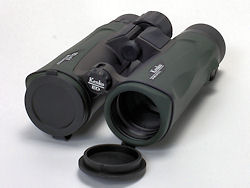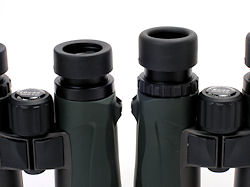Kenko 42-mm ultraVIEW EX DH ED Binoculars
|
|
Review Highlights
- Kenko’s
low-cost, 42-mm ED glass binoculars
- Bright,
crisp, rich image quality
- Lightweight,
comfortable open-bridge design
|
We previously reviewed a really
nice product from Kenko: an ultra-light 32-mm binocular that offered a
great combination of optical quality and ergonomics at a very affordable
price (see Kenko ultraVIEW EX binocular review here). Kenko has since brought
us more binoculars for evaluation, and one of them just jumped out at
us. That binocular is the “big brother” of the 32-mm ultraVIEW EX
that we reviewed earlier, a 42-mm version featuring ED (extra-low dispersion)
glass, for even better image quality. We knew right away that at this
quality at these prices ($369.00
for the 8x42 model,
$399.00
for the 10x version), the 42-mm ultraVIEWs will be significant products.
Physical
Properties
The ED Kenko ultraView EX binoculars
come in 8x42 and 10x42 models. These are roof prism binoculars, built
on polycarbonate chassis, which keeps the weight down. The 8x model weighs
just 25.0 oz. with lens caps, rainguard and strap included; the 10x model
weighs 25.4 oz. in the same state. (We publish the weight of an optic
with all the accessories we expect people to carry into the field rather
than a lower number that doesn’t reflect the actual expected user weight.)
It’s probably worth noting that the average 42-mm binocular usually
weighs a good 2.5 - 3.0 oz. more than this. Like most roof prism binoculars,
42-mm ultraVIEW ED binoculars are fully sealed to be waterproof, dust-proof
and internally fog-proof. The physical dimensions of the full-sized ultraVIEWs
are the same for both models: 6.4 inches tall by 5 inches wide, when the
eyecups are all the way up and the hinge fully extended. As noted, these
binoculars use an open-bridge design, leaving space for 2-3 fingers to
wrap around the ocular tube on one side and slip into the space between
the bridges. This makes for a comfortable, secure grip and allows for
one-handed use when the occasion warrants it (we don’t recommend a one-handed
grip for standard viewing). UltraVIEW ED binoculars have an interpupillary
distance range of 53-75 mm, which is a broader than average range on a
42-mm binocular. This means that the Kenko 42-mm ultraVIEWs are more likely
to fit your face more comfortably than many binoculars, particularly if
you have more of a narrow face. Is it a huge thing? No! Is it a good thing?
Yes!
Optical
Performance
In field testing of the ultraVIEW
ED binoculars, we were impressed with their overall brightness, and the
image sharpness and color-richness. These features are all impacted by
the use of the ED glass, which tends to improve on these properties relative
to normal lens glass. The prisms are made with BaK4 glass, which is pretty
much industry-standard for high-quality roof prism binoculars. The 8x42
ultraVIEW ED binocular has 18 mm of eye relief, more than enough for most
eyeglass wearers to use comfortably; the 10x model is a bit shorter at
15 mm, which is potentially a problem for eyeglass wearers of more extreme
prescriptions. The 8x and 10x models have published fields of view of
387 and 320 feet at 1000 yards distance. Relative to binoculars in their
class, that’s a bit below average for the 10x, but a bit bigger than
average on the 8x. But that may not really be the point. While field testing
the Kenko ultraVIEWs alongside other binoculars of similar price and properties,
we found that while the ultraVIEWs had a slightly smaller detectable field
of view, they had a larger sweet spot than other binoculars in their class.
The sweet spot is the center part of the field of view that is sharp.
We think of it as the “useful field of view”: that part of the total
visual field that is actually sharply in focus? The blurry portion of
the field really isn’t useful. In some binoculars with a larger total
field of view, the portion of the field that is actually sharp and useful
is smaller than on some binoculars with a smaller published field of view.
The ultraVIEWs are one of those binoculars that have a smaller total field
of view, but a larger useful field of view.
Focusing

The focus knob on the full-sized
ultraVIEW EDs is conveniently large, and covered with a soft rubber armoring
that yields very nice purchase to the fingers. The focusing action was
very smooth and precise. We measured the minimum close focus of both models
and found that they differed somewhat, with the 8x model close-focusing
to a distance of 7.8 feet, while the 10x model allows you to get a bit
closer at 7.3 feet. Both models require 1.7 turns of the focus knob to
go from minimum close focus to infinity, which is just about right, in
our view. One aspect of binocular image quality that is impossible to
quantify but actually kind of important is depth of field. When we compare
binoculars for depth of field, we focus sharply on a particular object
and then try to determine how much of the area around the object, in front
or in back is still sharp. When we did this with the Kenkos, we were pleased
to note that they had the greatest depth of field of any binocular in
their class. Depth of field is something that you seldom notice during
normal use of a binocular, but it is more important than you might guess,
and it contributes greatly to the richness of the image you perceive.
Greater depth of field is a really good thing, and the Kenkos have it.
Glass
and Coatings
As noted above, the 42-mm ultraVIEW
binoculars are made with ED glass. The advantage of ED glass is that it
significantly reduces chromatic aberration, resulting in sharper image
quality with higher contrast. Like all high-quality roof prism binoculars,
Kenko ultraVIEW ED binoculars are phase-coated for better image sharpness
and more vivid color. These binoculars also feature BaK4 glass in the
prisms, which is the optics industry standard for higher quality binoculars.
The lenses are fully multi-coated to maximize light transmission and image
brightness.
User
Adjustments

The eyecups adjust with a helical
twist mechanism with a single firm detent between fully-in and fully-out.
When we say a firm detent, we mean that these eyecups don’t inadvertently
collapse while in the field. These are well engineered. While we’re
on the subject of eyecups, we noted an interesting difference in the eyecups
of the two models of the ultraVIEW EX binoculars. The 8x42 model has eyecups
with rounded edges that are very comfortable against the face. The 10x42
model has eyecups with a flatter slightly beveled outer rim, and these
are slightly less comfortable. Both types of eyecup are made with a soft
pliable type of rubber, but we found those on the 8x42s to be preferable.
The diopter adjustment is a very simple twist-ring on the upper right
barrel. A raised line in the twist-ring lines up with a raised triangle
on the armoring of the barrel to indicate the position for equal eyes,
which makes adjustment very simple if you happen to have equal eyes. If
you don’t, then we recommend making a mark (use a permanent marker
or nail polish on the barrel) to indicate the diopter position that is
optimal for you. Otherwise, you will have to go through the laborious
process of adjusting the diopter because this is not a locking diopter
mechanism, and it will ultimately shift during use.
Peripherals
The rainguard is a pair of
soft rubber cups joined by a flexible linker region that fits snugly over
the eyecups and does not dislodge. You have to remove this rainguard by
intent, which is a good thing! The rainguard has a fixed bracket for threading
the strap through on the left, and a gapped bracket on the right, allowing
you to detach it and flip it out of the way when using the binocular.
The objective lens covers are again made of soft rubber, and tethered
to rings that fit over the objective ends of the barrels. The barrels
have a raised ridge that runs on the upper side. This ridge naturally
falls right at the intersection of the fingers with the palm of the hand,
so it also serves to give the user a more secure grip. But the ridge also
retards movement of the rings that the lens caps are tethered to, which
achieves two things. First, the rings don’t rotate involuntarily as
the ridge tends to anchor them in place. Second, the ridge increases tension
on the ring, which keeps them from falling off as easily. Both of those
are good things. Two other features of these objective lens caps that
we liked are the fact that the rubber is soft enough that the weight of
the caps is enough to cause them to dangle straight down, while the length
of the tethers is such that they don’t close inadvertently as the binocular
bumps against your chest. The case is a nylon-cordura affair with a Velcro
closure on the flap. This case is at least water-resistant if not fully
waterproof. There is a certain minimal padding to protect the binocular
from shocks, though whether it is enough to save it if you drop it is
debatable. (For obvious reasons, we don’t actually test that exhaustively!)
The nylon strap has a contoured, padded section that goes around the back
of the neck, and it’s fairly comfortable enough on a binocular of this
weight.
Conclusions
On the whole, we were quite
impressed with the 42-mm Kenko ultraVIEW ED binoculars. The image quality
is excellent. They have the large sweet spot and the better than average
depth of field, and the ergonomics are really quite good. These binoculars
compete very well with others in the same performance class and they cost
a bit less on average (all the others are over $400). We find that when
people take the time to look and compare, they often select these.
Buy Kenko
42-mm ultraView EX DH ED Binoculars